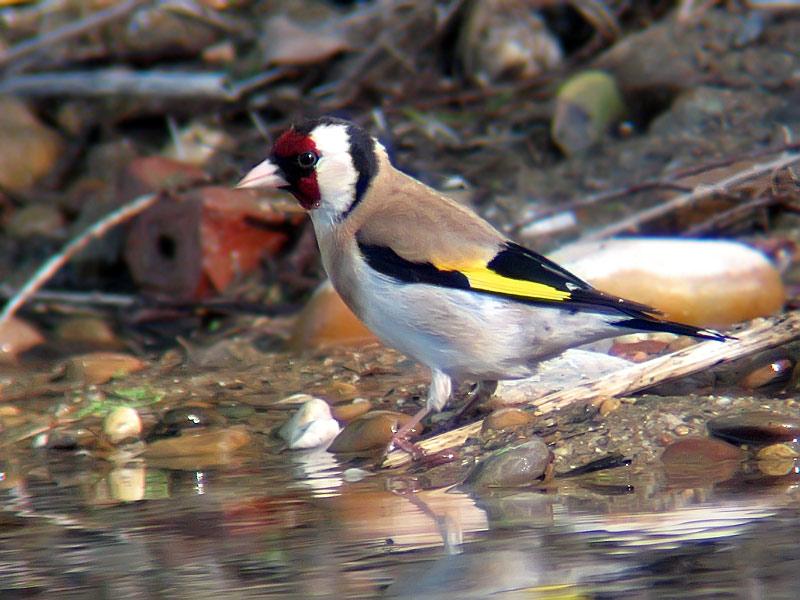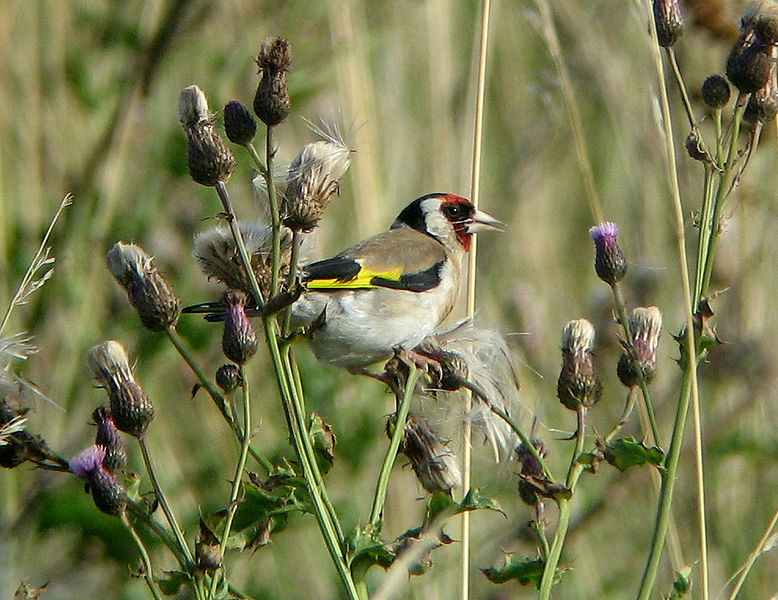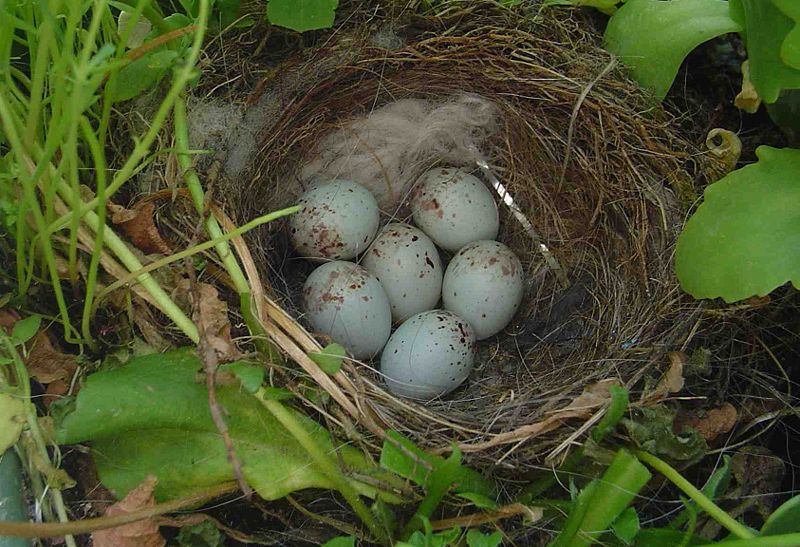 The American Goldfinch, Carduelis tristis, is one of North America’s most colorful and beloved birds. They are, however, protected by law and may not be kept as pets. However, the closely-related European Goldfinch, C. Carduelis, has long been bred in captivity and has even been crossed with canaries in order to improve their singing abilities. This colorful little acrobat may be legally kept in the USA and is a great choice for folks looking to expand their collections.
The American Goldfinch, Carduelis tristis, is one of North America’s most colorful and beloved birds. They are, however, protected by law and may not be kept as pets. However, the closely-related European Goldfinch, C. Carduelis, has long been bred in captivity and has even been crossed with canaries in order to improve their singing abilities. This colorful little acrobat may be legally kept in the USA and is a great choice for folks looking to expand their collections.
Description
The European Goldfinch is similar in size to its American cousin – 5 inches long and stoutly built. Its head is marked with alternating bands of red, white and black and the wings are banded in brilliant yellow. These wing bands are most evident in flight, and their sudden appearance usually elicits a gasp of pleasant surprise when seen for the first time.
The red feathers on the male’s face extend to the end of or just beyond the eye; on females the red feathers end at about mid-eye; the sexes are otherwise similar.
A variety of beautiful color mutations, including tawny, yellow, albino and pastel, have been developed by breeders; please see the article below for photos.
Range
The European Goldfinch’s huge range extends from the UK to central Russia in the north and from northern Africa to the Himalayas in the south. Introduced populations are established in Argentina, Uruguay, Australia, New Zealand and elsewhere. Strays occasionally turn up in the USA.
Keeping European Goldfinches
European Goldfinches may be housed and bred in large indoor flight cages. Their active lifestyles and acrobatic abilities also render them as ideal candidates for outdoor aviaries. They get along well with a variety of birds, including similarly-sized finches and Painted Quails, but breeding pairs will fight with other Goldfinches.
 Both sexes sing, with the male’s song being richer and more complicated than the female’s. It really is quite pleasant; please listen to the video below. European Goldfinches are sometimes mated to Canaries in order to add variety to the song of the latter. They will also breed with Linnets and Siskins, to which they are related (the Red Hooded Siskin, also popular among finch specialists, is responsible for the red factor Canaries we know today; please see article below).
Both sexes sing, with the male’s song being richer and more complicated than the female’s. It really is quite pleasant; please listen to the video below. European Goldfinches are sometimes mated to Canaries in order to add variety to the song of the latter. They will also breed with Linnets and Siskins, to which they are related (the Red Hooded Siskin, also popular among finch specialists, is responsible for the red factor Canaries we know today; please see article below).
Diet
A high grade finch seed mix can serve as the basis of your European Goldfinch’s diet. Thistle seed is considered to be of great value by European breeders, and nyger seed is a favorite. Millet sprays hung from perches will keep both you and your birds occupied and entertained for hours.
Small live insects (mealworms, waxworms, crickets), Egg Food and Softbill Pellets should be provided several times weekly; silkworms and other canned insects may be used to add variety to the diet.
Fresh sprouts, carrot tops and small amounts of chopped spinach, dandelion, romaine and other greens will round out the diet.
Increased amounts of protein-based foods and fresh produce are essential during the breeding season and for parents with chicks.
Grit and cuttlebone should always be available.
Breeding
 Breeding may occur in a large indoor cage but is more common in outdoor aviaries or bird rooms.
Breeding may occur in a large indoor cage but is more common in outdoor aviaries or bird rooms.
Males court prospective mates by swaying back and forth while beating their wings in a most amusing manner. A commercial canary nest, set as high as possible within their cage, will usually be accepted. Dried sphagnum moss or commercial nesting material should be available throughout the nesting season.
An average clutch contains 3-7 eggs which hatch in approximately 14 days. The young fledge at 2 weeks of age. Thereafter they are fed, primarily by the male, until achieving full independence.
Further Reading
Video: European Goldfinch singing
Photos of European Goldfinch color morphs
European Goldfinch feeding image referenced from wikipedia and originally posted by MPF
European Goldfinch Nest image referenced from wikipedia and originally posted by bukk
 That Bird Blog – Bird Care and History for Pet Birds
That Bird Blog – Bird Care and History for Pet Birds




at what age do the young goldfinches start to sing at.
Hi ian,
Approximately 1 year of age in the wild, but captives may mature several months earlier.
best, Frank
i have a pair of finches european
they’r butiful wanted to breed them, not sure how
can tips some advirse?
thank you
Hi Suzzie,
Glad you are interested in these gorgeous birds.
Breeding is most likely in an outdoor aviary or extremely large indoor cage (see article for links)…they need room and security; even if they are otherwise content, most pairs will not breed in typical cages. Commercial canary nests should be provided, and placed as high as possible. Hanging artificial plants positioned in front of the nests may help them to feel secure; sphagnum moss should be available as extra nesting material.
Exposure to a natural light cycle is helpful, and extra live food and sprouts provided in spring will help bring them into breeding condition. Canned insects may also be used. Some breeders keep the pairs separated until early spring, then introduce slowly.
Please keep me posted, enjoy, Frank
Hi, could u please tell me at what age can a goldfinch female and male can breed ? Is. Possible to breed them in the first year?
Hello Abdel,
They become sexually mature at approximately 1 year of age, sometimes a bit earlier (for captives). Please keep me posted, best, frank
Hi,
I have a pair of gold finch kept in a big outside cage made by covering the outside window. Plenty of sunshine and natural plant placed. They are in with few pair of gouldians. But male female always fight when they are close to each other. i have kept a canary nest camouflaged with the plant leaves.
need your expert tips and advice for pairing and breeding them
Hi,
Unfortunately there are no easy answers. Outdoor caging is best, but pairs mat still not come into breeding condition at the same time, especially if they are being kept outside of their natural range. Mate choice comes into play..not all are compatible. An abundance of novel seeds and insects offered as spring arrives may help, as will ample space, plenty of cover and nesting material. The presence of other birds can impede breeding, even if there is no aggression. Ideal conditions..plenty of insects, room, etc., and the lack of possible competition (other finches), as well as the proper light/temperature cycle is important in bringing them into condition, but mate choice is always a factor, Best, Frank
Hi.
I came by ur article trying to find a solution for my case. I used to raise canary birds and breed them and i am an experienced breeder. Also i raised some european goldfinches untill lately i wanted to try to breed them in cage. i supplied them with all the materials they need and placed them in a very calm place in a big cage. The couple seems to be intrested in eachother and i know that both are in breeding condition. the female started building the nest 6 days ago and now the nest looks complete and i can say that it is the most beautiful nest ive ever seen. but i dont know when she will lay eggs and i am concerned about the timing specially that ive never seen the couple mating. So i would be happy if u can supply me with some extra information about the time required after finishing the nest so that the hen can lay her eggs and when do they mate ? thank you very much.
Hello Elias,
It’s difficult to predict the timing because captive conditions – light cycles, temperature etc. change birds’ natural hormonal flow, breeding cycles. Mating is very quick, so it’s easy to miss. As with canaries, egg-bindng will be evident; other wise, best to just give them time. Best, frank
thank you. i think ill just wait and ill let u know what will happen.
My pleasure..yes, pleasse keep me posted, enjoy, Frank
Thanx for putting this together Frank. One of my 2 pairs have nested at thge top of the aviary (our screened deck) and the female is now setting. We lost the last 2 clutches (nests in low plants) to rat snakes. We’re hoping for the best this time. I’ll let you now. Cheers/dick
Hi Dick,
Nice to hear from you…I miss working with these, and am jealous of your having rat snakes to worry about – definitely need to move south! I look forward to good news…
Enjoy, and my best to Patti, Frank
hi frank, i have just had 2 goldfinches, cock and hen and they are 1 year old, i put them in a double breeding cage.the date is 1/8/14 is it to late for them to breed.
Hello Eddie,
Captives are usually not so closely-tied to the seasons as are wild birds, so there is a chance. I hope all goes well, please keep me posted, Frank
hi frank,thankyou for the last reply to my question, as i asked if the 2 golfincges would breed this year, but now i am concerned about the 2 young goldfinches being brother and sister, is there any way i can tell if they are brother and sister. thankyou. eddie
Hello Eddie,
My pleasure. Other than by genetic testing, no way to determine relationship. Always good to mix breeders, but a first cross should not be a problem…if possible, check with your source as to their history…if the line is already inbred, then it would be best to avoid crossing siblings, best, Frank
Hello Frank,
I’m well aware that dandelion is beneficial to most finches I have one concern regarding the stem with its milky sap.. It would be very much appreciated to here your comments as to whether this part of the plant should be used.
Many thanks Gerald
Hello Gerald,
The sap is often mentioned in passing as a possible concern, but I’ve not seen anything in the way of a journal article etc to indicate a problem. I’ve used stems and leaves in salads offered to a wide variety of birds and reptiles at the Bx Zoo for many year..but no need to provide stems if you are concerned, leaves are adequate. happy, healthy New Year, Frank
Hi Frank,
Many thanks for your reply, should I have a spare cock or hen I will throw a complete dandelion in the cage and see what happens. I expect it will be uneventfull, but will watch for a few hours before removing.
Thanks again and a happy new year to you, Gerald
My pleasure, Gerald. Please keep me posted, Frank
hi
what is the best cure of intestine infection of goldfinch.
tnx
Hello,
Unfortunately,Infections cannot be diagnosed or treated without veterinary intervention. Please let me know if you need help in locating an avian vet. best, Frank
hi Frank
I have a pair of goldfinch
I got a female at the beginning of last spring and I got a male in the late spring
Both completed phase change feathers
Of course the female has completed phase change about a month, before the male
She is ready to breed, in its beak color perfectly pink
Evidence of the entry phase of reproduction
Male, became a singing loud and clear voice, but its beak which remained some blackness
It is far from the breeding stage about a month
Is this late in males, Hurt reproduction stage, Among female ?
I have a outdoor aviary
Both separately on the other
The female in the big space
Both do not see each other
Thank you very much
Hello,
Captive conditions often effect the timing of breeding, although in outdoor enclosures this is less of a problem. It would be worthwhile to try an introduction soon, as the presence of a mate can speed up the process…but watch them carefully, as if both are not at the same stage of readiness, aggression can result. I hope all goes well, please keep me posted, frank
hi frank can you offer any advice on breeding the american goldfinch in a large cage ,i have a large flight and aviary but not sure about putting them out as they look delicate the flight has pekin robins and grosbeaks in it so can these be bred in a cage
Hello Martin,
They may or may not get along with the grosbeaks…so many factors involved, as you know.
They have been bred in cages..the larger the better; they build an open nest, and will utilize a commercial canary nest as a base upon wich to build..hanging plants etc near the nest will encourage them to use it. They are stimulated to breed by seasonal changes, being largely temperate in distribution, but captive pairs may breed at other times as well. Please keep me posted.
What types of grosbeak do you keep?…wonderful birds, but not often kept in private or public collections here in the US. Best, Frank
hi frank thank you for reply i have the white winged grosbeak they seem very placid they do not pay much attention to exploring the aviary etc 40ft x 20ft plus shelter . the american goldfinch are kept separate in a cage in another shed which is about 14-19 degrees (not controlled ) and keep the light on for 15-16 hrs (no dimmer ) if possible can you offer any detailed advice on breeding the american goldfinch ie diet
conditioning raising chicks etc or can you put me in touch with someone who has breed these successfully ( also i keep the northern and yellow cardinal ) ps is it true that the white winged grosbeak will only raise chicks if it has a constantant supply of snails? martin
Hi Martin,
Thanks for your email and for following up here (this allows others to read as well). Very nice group of birds you have!
American goldfinches would be stimulated by seasonal changes and an increase in insects in the diet, as far as I know…unfortunately, zoos here in the USA give them little attention and private keepers cannot keep any native species except under a rehab license. But being temperate birds over most of the range, they can be bred as for the European goldfinch.
I’ve not worked with white-winged grosbeaks; the sources I have at hand do not mention snails as being essential…wondering if perhaps , as with some species, the appearance of a seasonal food such as snails is a breeding stimulus? But as for it being an essential chick food, I cannot say…please let me know if you learn anything further, and please keep me posted on your collection, best, frank
thank you for the response frank will research the european goldfinch and apply those recomendations ,thank you for you attention will keep you posted
Enjoy, Martin, and best of luck; looking forward to hearing from you, as are readers here in the US, I’m sure. Best regards, Frank